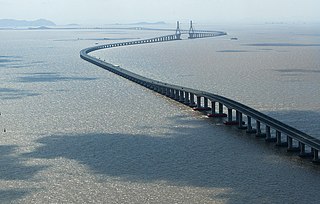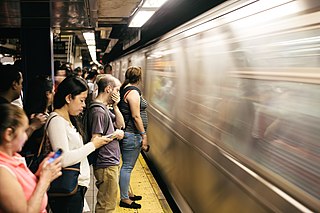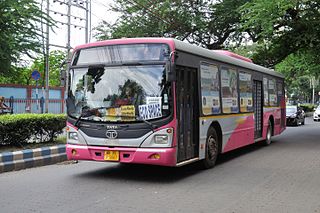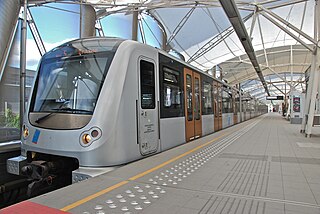This article considers transport in Armenia.

Transport in Japan is modern and highly developed. Japan's transport sector stands out for its energy efficiency: it uses less energy per person compared to other countries, thanks to a high share of rail transport and low overall travel distances. Transport in Japan is also very expensive in international comparison, reflecting high tolls and taxes, particularly on automobile transport. Japan's spending on roads has been large. The 1,200,000 kilometres (750,000 mi) of paved road are the main means of transport. Traffic in Japan drives on the left. A single network of high-speed, divided, limited-access toll roads connects major cities, which are operated by toll-collecting enterprises.

Transport in China has experienced major growth and expansion in recent years. Although China's transport system comprises a vast network of transport nodes across its huge territory, the nodes tend to concentrate in the more economically developed coastal areas and inland cities along major rivers. The physical state and comprehensiveness of China's transport infrastructure tend to vary widely by geography. While remote, rural areas still largely depend on non-mechanized means of transport, urban areas boast a wide variety of modern options, including a maglev system connecting the city center of Shanghai with Shanghai Pudong International Airport. Airports, roads, and railway construction will provide a massive employment boost in China over the next decade.
Transportation in South Korea is provided by extensive networks of railways, highways, bus routes, ferry services and air routes that traverse the country. South Korea is the third country in the world to operate a maglev train, which is an automatically run people mover at Incheon International Airport.

A rush hour or peak hour is a part of the day during which traffic congestion on roads and crowding on public transport is at its highest. Normally, this happens twice every weekday: once in the morning and once in the afternoon or evening, the times during which most people commute. The term is often used for a period of peak congestion that may last for more than one hour.

The Beijing Subway is the rapid transit system of Beijing Municipality that consists of 27 lines including 22 rapid transit lines, two airport rail links, one maglev line and 2 light rail lines, and 490 stations. The rail network extends 836 km (519 mi) across 12 urban and suburban districts of Beijing and into one district of Langfang in neighboring Hebei province. With 3.8484 billion trips delivered in 2018, an average of 10.544 million trips per day, the Beijing Subway is the world's busiest metro system. Single-day ridership set a record of 13.7538 million on July 12, 2019.
Beijing possesses multiple ring roads.

The transport network in Greater Tokyo includes public and private rail and highway networks; airports for international, domestic, and general aviation; buses; motorcycle delivery services, walking, bicycling, and commercial shipping. While the nexus is in the central part of Tokyo, every part of the Greater Tokyo Area has rail or road transport services. There are also a number of ports offering sea and air transport to the general public.

The transport system of Kolkata, a city in India, is a mix of modern mass rapid transport and old transport modalities like rickshaws. Kolkata is connected to the rest of India by the National Highways, the extensive network of the Indian Railways, National Waterways and by air. The most traffic to Northeast India route is via Kolkata.

Delhi has significant reliance on its transport infrastructure. The city has developed a highly efficient public transport system with the introduction of the Delhi Metro, which is undergoing a rapid modernization and expansion since 2006. There are 16.6 million registered vehicles in the city as of 30 June 2014, which is the highest in the world among all cities, most of which do not follow any pollution emission norm, while the Delhi metropolitan region has 11.2 million vehicles. Delhi and NCR lose nearly 42 crore man-hours every month while commuting between home and office through public transport, due to the traffic congestion. Therefore, serious efforts, including a number of transport infrastructure projects, are under way to encourage usage of public transport in the city.
Transport in Tianjin consists of an extensive network of roads and railways and a major airport. Bicycle is a major means of transport in daily use of the city.

Beijingnan railway station is a large railway station in Fengtai District, Beijing, about 7.5 km (4.7 mi) south of central Beijing, between the 2nd and 3rd ring roads. The station in its present form opened on 1 August 2008 and mainly serves high speed trains.
A through service is a concept of passenger transport that involves a vehicle travelling between lines, networks or operators on a regularly specified schedule, on which the passenger can remain on board without alighting. It may be in form of either the following:

Beijing, alternatively romanized as Peking, is the capital of the People's Republic of China. With over 21 million residents, Beijing is the world's most populous national capital city as well as China's second largest city after Shanghai. It is located in Northern China, and is governed as a municipality under the direct administration of the State Council with 16 urban, suburban, and rural districts. Beijing is mostly surrounded by Hebei Province with the exception of neighboring Tianjin to the southeast; together, the three divisions form the Jingjinji megalopolis and the national capital region of China.

Brussels has an extensive network of both private or public transportation means. Public transportation includes Brussels buses, trams, and metro, as well as a set of railway lines and railway stations served by public trains. Air transport is available via one of the city's two airports, and boat transport is available via the Port of Brussels. Bicycle-sharing and car-sharing public systems are also available. The city is relatively car-dependent by northern European standards and is considered to be the most congested city in the world according to the INRIX traffic survey.

Beijing Daxing International Airport, is one of two international airports serving Beijing, the capital city of China, the other one being Beijing Capital International Airport (PEK). It is located on the border of Beijing and Langfang, Hebei Province. It has been nicknamed "the starfish." It was completed on June 30, 2019, and began operations on September 26, 2019. Beijing Daxing covers an expanse of 2,679 hectares and has four civilian runways and one military runway.

Public bus service in Beijing is among the most extensive, widely used and affordable form of public transportation in urban and suburban districts of the city. In 2015, the entire network consisted of 876 routes with a fleet of 24,347 buses and trolleybuses carried 3.98 billion passengers annually. Trolleybuses run on over 31 routes including 6, 38, 42, 65, 101-112, 114-118, 124, 128, 301, BRT 1-3. Many of these trolleybus routes are located inside the Third Ring Road but some, such as 301 and BRT 1-3, do extend as far out as the Fifth Ring Road. Since 2013, In an effort to reduce urban air pollution, Beijing has been converting regular bus routes to trolleybus routes by installing overhead power lines on several corridors. Public bus service in the city began in 1921. Today there are two operators. The city's primary public bus operator, the state-owned Beijing Public Transport Holdings, Ltd. operates the Bus Service.

The Jingjinji Metropolitan Region or Jing-Jin-Ji (JJJ), is the National Capital Region of the People's Republic of China. It is the biggest urbanized megalopolis region in North China, including an economic region surrounding the municipalities of Beijing and Tianjin, and along the coast of the Bohai Sea. This emerging region is rising as a northern metropolitan region rivaling the Pearl River Delta in the south and the Yangtze River Delta in the east. In 2020, Jingjinji had a total population of 110 million people, comparable to that of the Philippines.

Daxing Airport Express of the Beijing Subway is an airport rail link from Caoqiao to the Beijing Daxing International Airport. It is colored blue on subway maps. The line opened on September 26, 2019.

Shenzhen has an extensive transport network, including various forms of land, water and air transport.






























